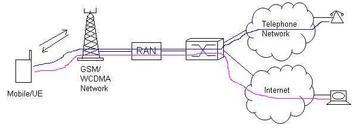
Circuit Switched vs. Packet Switched Calls: Key Differences
Explore the differences between circuit-switched and packet-switched calls. Understand how they work, their best applications, and call flow examples for GSM and WCDMA networks.
Advertisement

Explore the differences between circuit-switched and packet-switched calls. Understand how they work, their best applications, and call flow examples for GSM and WCDMA networks.

Explore the advantages and disadvantages of contact tracing technology, its application during the COVID-19 pandemic, and its impact on privacy and security.

Explore the benefits and drawbacks of Cloud RAN (CRAN) technology, including faster deployment, reduced costs, and high fronthaul capacity requirements.
Explore the distinctions between CT0, CT1, and CT2 analog cordless telephone standards. Understand frequencies, duplexing, access types, and modulation.
CTCSS and DCS are signaling systems used in walkie-talkies to reduce interference and filter unwanted transmissions, enabling clearer communication. CTCSS uses analog tones, while DCS uses digital codes.

Learn about the DigRF interface, a standard for connecting baseband and RF ICs in mobile devices. Covers versions, specifications, and applications.

Understand Doppler spread and coherence time, key concepts in wireless communication, and how they relate to fading and channel characteristics.

Explore the differences between Ec/Io and Eb/No in WCDMA, focusing on their measurement points (before and after despreading) and importance in evaluating wireless system performance.
Explore the differences between EDGE and GPRS, focusing on data rates, modulation techniques, retransmission capabilities, and more. Understand how EDGE enhances GPRS.

Explore the benefits and drawbacks of eSIM technology for end-users, operators, and device manufacturers. Learn about global connectivity, security, and potential privacy concerns.

Explore the differences between eSIM and traditional SIM cards, including their advantages, disadvantages, and suitable use cases. Understand which option better fits your needs.
Explore the fundamentals of EVDO (Evolution-Data Optimized), its different revisions (Rev. 0, A, and B), and their key features, data rates, and improvements.

Explore the distinctions between FDMA and FHMA, two multiple access techniques used in wireless communication. Learn about frequency division and hopping approaches.

Explore FDMA, TDMA, and CDMA multiple access techniques, their principles, advantages, and applications in telecom networks, including examples and a detailed comparison.
Explore the fundamental differences between fixed (landline) and wireless telephone networks, covering infrastructure, mobility, and network management.

Explore the free duplex concept in 6G mobile, contrasting it with fixed and flexible duplex methods. Learn about its advantages, including increased throughput and improved spectrum efficiency.

Explore the key differences between GFSK and GMSK modulation techniques, their applications, and advantages in wireless communication systems.
Overview of various GNSS data formats like NMEA, RINEX, RTCM, SP3, BINEX, and GPX, used for transmitting GNSS data to receivers, including their purpose and contents.

Explore the differences between GNSS and GPS, including their architecture, satellite systems, accuracy levels, and applications in various industries.

Explore the fundamentals of Google Fi (formerly Project Fi), its network architecture, how it seamlessly switches between Wi-Fi and cellular, and device compatibility.
Advertisement